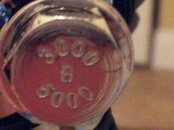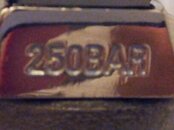We can argue about the semantics of the service pressure sticker on the valve, but the reality is that it is a workable burst disc for the tank. There are three factors that are working together here to allow that to happen.
1) Technically the burst disc has to it blow between 90% and 100% of the test pressure so it can go anywhere between 4,500 psi and 5,000 psi for a 3,000 psi service 3AL aluminum tank where the test pressure is 5/3rds the service pressure (5000 psi).
2) Test pressures for 3AL and 3AA tanks are 5/3rds the service pressure. But for special permit tanks, the standard is to use a test pressure that is 3/2 the service pressure.
3) The people that make burst discs are pretty good at engineering them to go at fairly exact pressures.
So for a 3AL aluminum tank (the normal destination for a 3,000 psi service tank), the test pressure is 5,000 psi, thus the 3000/5000 marking on the disc assembly. And as noted above, that particular disc will blow very close to 5,000 psi - in the 4,800-5,000 psi range when new.
With the X7-100 tank the service pressure is 3,442 psi, however the test pressure is 3/2 the service pressure, or 5,163 psi. And, the burst disc must fail between 4,647 psi and 5,163 psi. Due to the difference in engineering standards and required test pressures, there is just not much difference in the burst disc requirements.
Also consider the not all that common 3,180 psi 3AA steel tank which holds 3,498 psi at the plus rated pressure and has a 5/3 rds derived test pressure of 5,300 psi. Here the burst disc here has to go between 4,770 psi and 5,300 psi - a little higher, but not much.
Finally, consider the older 3,500 psi genesis tanks that also had a 3/2 test pressure - in that case 5,250 psi, requiring a burst disc that fails between 4,725 psi and 5,250 psi. This assembly is commonly marked 3500/5250 and nobody blinks if you use one in a 3,442 psi tank, although technically if it does not blow until 5,250 psi it's 137 psi too much to be technically "legal" in a 3,442 psi tank.
So the burst disc pressures for various tanks:
3AL 3000 psi tank =.......between 4,500 psi and 5,000 psi
X7-100 3442 psi tank = ..between 4,647 psi and 5,163 psi
3AA 3,180 psi tank = .....between 4,770 psi and 5,300 psi
Genesis 3,500 psi tank = between 4,725 psi and 5,250 psi
Based on this, all you need to be "legal" with all 4 tank types is a burst disc that ruptures between 4,770 psi and 5,000 psi.
The 3000/5000 disc assembly is going to do that, at least within the limits of practical real world experience and pressure gauges.
The only problem in the real world is that the sticker on the valve indicates a 3,000 psi service pressure and the above information is way more than the average tank monkey has, so they'll default to the sticker rather than any rational argument about regulatory requirements and test pressures based on differing engineering standard-
----
What really matters in a fire is that they blow before the test pressure is reached, so from a safety perspective I can live with a disc that goes at 5,000 psi rather than at 5,163 psi. Burst discs are subject to fatigue and corrosion so over time the burst pressure drops, and that is where the 90% limit is nice, as it ensures a large margin over the test pressure. But again the 3000/5000 assembly in a 3,442 psi tank still gives you a margin of at least 1,058 psi even with the 163 psi lower theoretical burst limit of *only* 4,500 psi. You'd need a hell of an over fill for that to become a problem. I replace my burst discs every 5 years when the tank is hydro tested, when I also rebuild the valve. If for some reason I rebuild the valve in the interim, then I also replace the disc as the valve has pretty much by virtue of needing rebuilt seen extensive use or abnormally harsh conditions.
If it were my tank, I'd slap a 3442 psi sticker on it and call it good. In fact, all 4 of my 3442 psi X7-100s have 3000/5000 disc assemblies in them now - with the original "3442" stickers on the valves.
----
The irony here is that where it starts getting shaky using a 3000/5000 burst disc is with the 3,300 psi 3AL tanks like the AL 100 and neutral 80 where the burst disc pressure must be between 4,950 and 5,500 psi. That only leaves a 50 psi window and you probably won't get that kind of precision in a 3000/5000 psi burst disc - but those are tanks that the tank monkey WON'T question if they have a 3,000 psi service sticker on the valve, they'll just fill them - probably to 3,000 psi as they probably won't even recognize them as 3,300 psi service pressure tanks, because they are aluminum.








